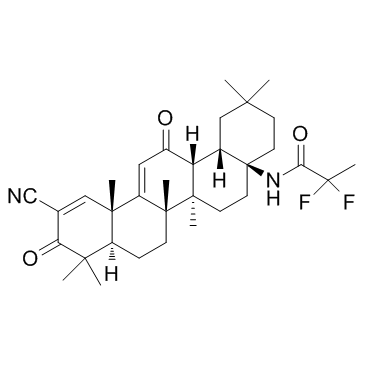RTA-408
Modify Date: 2024-01-04 23:46:01

RTA-408 structure
|
Common Name | RTA-408 | ||
|---|---|---|---|---|
| CAS Number | 1474034-05-3 | Molecular Weight | 554.711 | |
| Density | 1.2±0.1 g/cm3 | Boiling Point | 662.0±55.0 °C at 760 mmHg | |
| Molecular Formula | C33H44F2N2O3 | Melting Point | N/A | |
| MSDS | N/A | Flash Point | 354.2±31.5 °C | |
Use of RTA-408RTA-408 is an antioxidant inflammation modulator (AIM), which activates Nrf2 and suppresses nitric oxide (NO). |
| Name | RTA-408 |
|---|---|
| Synonym | More Synonyms |
| Description | RTA-408 is an antioxidant inflammation modulator (AIM), which activates Nrf2 and suppresses nitric oxide (NO). |
|---|---|
| Related Catalog | |
| Target |
Nrf2[1] |
| In Vitro | To evaluate the anti-inflammatory activity of RTA-408, RAW 264.7 mouse macrophage cells are treated with RTA-408 for two hours and then IFNγ is added to stimulate NO production and release into the media. RTA-408 dose-dependently reduces NO concentrations in the media with an IC50 value of 4.4±1.8 nM. The potency of RTA-408 in this assay is similar to that of Bardoxolone methyl, which has an IC50 value of 1.9±0.8 nM. Nrf2 activation is required for AIM-mediated NO suppression. A decrease in nitric oxide synthase 2 (Nos2) protein levels is observed in bardoxolone methyl-treated RAW 264.7 cells, which is attenuated when Nrf2 mRNA levels are reduced by siRNA. To evaluate the anticancer activity of RTA-408, a panel of eight human cell lines derived from tumors of different origin are treated with RTA-408 and measured cell growth 72 hours later using the sulforhodamine B (SRB) assay. RTA-408 inhibits the growth of all tumor lines with an average GI50 value of 260±74 nM. To determine whether RTA-408 induces apoptosis, the panel of tumor cells are treated with RTA-408 and the caspase substrate, DEVD-AFC, for 24 hours. RTA-408 dose-dependently increases DEVD-AFC cleavage, indicating that RTA-408 treatment triggers caspase activation in cancer cells. Caspase-3 and caspase-9 cleavage is also observed by western blot at the same concentrations of RTA-408 that increases DEVD-AFC cleavage[1]. |
| In Vivo | To determine whether RTA-408 is an effective mitigator of hematopoietic acute radiation syndrome after bone marrow-lethal doses of total-body irradiation (TBI), mice are administered 3 daily injections of 17.5 mg/kg RTA-408 beginning 24 h after TBI. Teatment with RTA-408 results in the 35 day survival of 100% of 7 Gy (LD40/35) TBI mice (P<0.05) and 60% of 7.5 Gy (LD100/13) TBI mice (P<0.0001)[2]. |
| Cell Assay | MEFs, PANC-1, A549, A375, A549/NF-κB-Luc and HeLa/NF-κB-Luc cells are cultured in Gibco high glucose DMEM with 10% FBS. G-361 cells are cultured in McCoy’s 5A medium with 10% FBS. All other cell lines are cultured in RPMI 1640 medium with 10% FBS. For growth inhibition assays, cells are plated in duplicate 96-well culture dishes at 3×103 cells per well. The following day, one plate is treated with RTA-408 (200, 400, 600, 800 and 1000 nM) and the other is immediately processed for the sulforhodamine B (SRB) assay (time 0). Cells in the RTA-408-treated plate are processed for the SRB assay 72 hours after the start of treatment. Percentage of growth relative to vehicle-treated cells is calculated. Dose-response curves are plotted in GraphPad Prism and GI50 values are calculated. For cell counting experiments, MEFs are plated in 6-well culture dishes at 5×104 cells per well and treated with RTA-408 the following day. Following treatment, cells are counted using a Vi-CELL XR cell analyzer. For clonogenic assays, wild-type (1×103 cells per well) and Keap1-/- (0.5×103 cells per well) MEFs are seeded in 6-well dishes. Six hours later, MEFs are treated with RTA-408. After seven days, colonies are fixed with a 1:7 solution of acetic acid:MeOH and stained with 0.5% crystal violet in MeOH. Colonies consisting of ≥50 cells are counted[1]. |
| Animal Admin | Mice[2] For radiation survival experiments, wild-type C57Bl/6 CD45.2 mice (6-8 weeks old) are used. Congenic wild-type C57Bl/6 CD45.1 and C57Bl/6 CD45.1/CD45.2 hybrid host mice are used as recipients in transplantation experiments. RTA-408 stock solutions for vehicle control (DMSO) are prepared within 1 h before injection. RTA-408 (17.5 mg/kg) or DMSO is administered intraperitoneally at 24, 48 and 72 h after irradiation. Whole-body irradiation (7-8 Gy) is performed using a 250-kVp X-ray machine with 50 cm source-to-skin distance and a 2 mm copper filter. The dose rate is approximately 1.4 Gy/min. |
| References |
| Density | 1.2±0.1 g/cm3 |
|---|---|
| Boiling Point | 662.0±55.0 °C at 760 mmHg |
| Molecular Formula | C33H44F2N2O3 |
| Molecular Weight | 554.711 |
| Flash Point | 354.2±31.5 °C |
| Exact Mass | 554.331970 |
| LogP | 5.64 |
| Vapour Pressure | 0.0±2.0 mmHg at 25°C |
| Index of Refraction | 1.549 |
| Storage condition | -20℃ |
| RTA-408 |
| RTA 408 |
| UNII-G69Z98951Q |
| (1E)-N-[(4aS,6aR,6bS,8aR,12aS,14aR,14bS)-11-Cyano-2,2,6a,6b,9,9,12a-heptamethyl-10,14-dioxo-1,3,4,5,6,6a,6b,7,8,8a,9,10,12a,14,14a,14b-hexadecahydro-4a(2H)-picenyl]-2,2-difluoropropanimidic acid |
| Propanamide, N-[(4aS,6aR,6bS,8aR,12aS,14aR,14bS)-11-cyano-1,3,4,5,6,6a,6b,7,8,8a,9,10,12a,14,14a,14b-hexadecahydro-2,2,6a,6b,9,9,12a-heptamethyl-10,14-dioxo-4a(2H)-picenyl]-2,2-difluoro- |
| Propanimidic acid, N-[(4aS,6aR,6bS,8aR,12aS,14aR,14bS)-11-cyano-1,3,4,5,6,6a,6b,7,8,8a,9,10,12a,14,14a,14b-hexadecahydro-2,2,6a,6b,9,9,12a-heptamethyl-10,14-dioxo-4a(2H)-picenyl]-2,2-difluoro-, (1E)- |
| omaveloxolone |
| N-[(4aS,6aR,6bS,8aR,12aS,14aR,14bS)-11-Cyano-2,2,6a,6b,9,9,12a-heptamethyl-10,14-dioxo-1,3,4,5,6,6a,6b,7,8,8a,9,10,12a,14,14a,14b-hexadecahydro-4a(2H)-picenyl]-2,2-difluoropropanamide |
| MFCD28167769 |
| N-(2-cyano-3,12-dioxo-28-noroleana-1,9(11)-dien-17-yl)-2,2-difluoropropanamide |